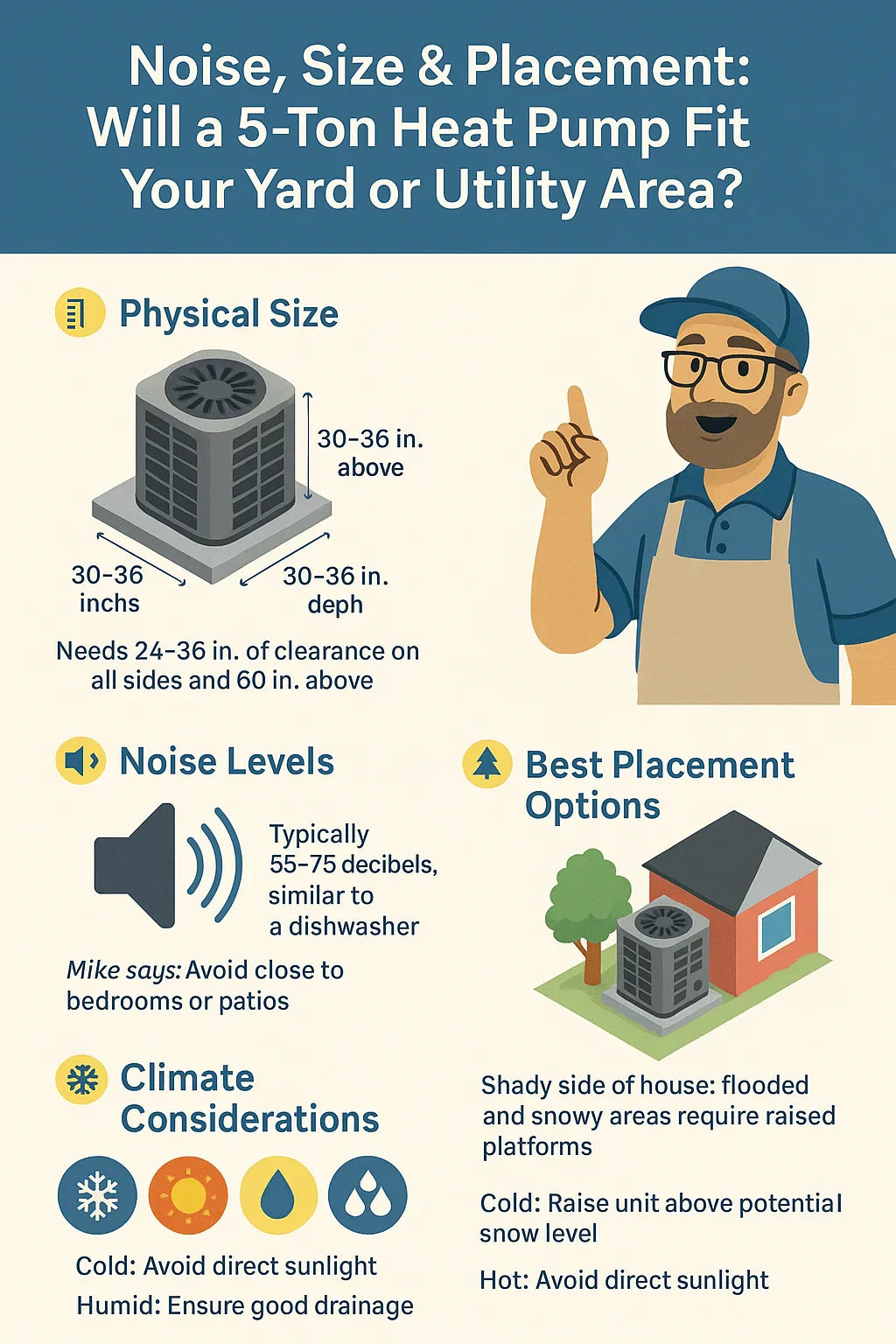🏠 Introduction: Planning Before You Buy
Installing a 5-ton heat pump is one of the biggest HVAC decisions you’ll make for your home. Beyond efficiency ratings and cost, you need to consider whether the unit will physically fit in your yard or utility space—and whether it will operate without disturbing your comfort or your neighbors. From noise levels to clearance requirements, these factors can make or break your system’s performance.
Mike’s Tip: “A 5-ton system is powerful, but it’s not invisible. Plan for space, airflow, and noise before you install.”
📏 Physical Size: How Big Is a 5-Ton Heat Pump?
Typical Dimensions
A 5-ton outdoor condenser typically measures:
-
Height: 36–42 inches
-
Width/Depth: 30–36 inches each
-
Weight: 200–350 pounds
Think of it like the footprint of a large trash bin or compact washer.
Clearance Rules
To ensure proper airflow:
-
Leave 24–36 inches of space on all sides.
-
Allow 60 inches overhead for unobstructed discharge.
-
Keep minimum 5 feet from windows, doors, and outdoor seating areas.
Why Clearance Matters
-
Prevents overheating of the compressor
-
Ensures quiet operation
-
Reduces strain, improving energy efficiency and lifespan
👉 Resource: Carrier – Outdoor Unit Placement
🔊 Noise Levels: What to Expect from a 5-Ton Unit
Typical Sound Ratings
-
55–75 decibels (dB), about as loud as a dishwasher or normal conversation
Factors That Influence Noise
-
Compressor Type:
-
Variable-speed = quietest
-
Two-stage = moderate
-
Single-stage = loudest
-
-
Installation Quality: Loose panels and poor placement amplify sound.
-
Proximity to Living Spaces: Units near bedroom windows may disrupt sleep.
Noise-Reduction Options
-
Sound blankets for compressors
-
Privacy fences with acoustic lining
-
Strategic placement behind garages or sheds
👉 Reference: Energy.gov – Heat Pump Systems
Mike’s Tip: “If you like sleeping with windows open, keep the condenser away from bedrooms.”
🌳 Best Placement Options for Outdoor Units
Yard Installations
-
Place on the shaded side of the home for better efficiency.
-
Avoid low-lying areas prone to standing water.
-
Keep clear of gutters or roof lines that dump snow/ice.
Utility Closets or Mechanical Rooms
-
Possible with proper ventilation and clearances.
-
Check local codes—many require outdoor placement for 5-ton systems.
Roof or Raised Platforms
-
Useful in flood-prone areas.
-
Requires structural support to handle weight.
👉 Resource: ENERGY STAR – Outdoor Installation Tips
🧊 Climate Considerations for Placement
Cold Climates
-
Elevate unit on a stand to avoid snow accumulation.
-
Ensure defrost cycles have proper drainage.
Hot Climates
-
Install in shaded areas to reduce compressor load.
-
Avoid west-facing walls that capture afternoon sun.
Humid Climates
-
Keep drainage around the pad clear to prevent algae/mold growth.
-
Consider a gravel base to avoid mud and pooling water.
⚖️ Size & Placement Trade-Offs
| Concern | Impact | Mike’s Recommendation |
|---|---|---|
| Limited Yard Space | Reduced airflow, higher bills | Choose a compact variable-speed model |
| Close to Bedrooms | Sleep disruption | Install noise-reduction fencing or blanket |
| Flood-Prone Area | Damage risk | Use elevated stand or roof mount |
| Tight Utility Closet | Safety/code compliance issues | Relocate outdoors if possible |
🛠️ Installation Prep Checklist
-
✅ Measure yard or utility space before ordering
-
✅ Confirm HOA or city noise regulations (some limit decibels)
-
✅ Prepare a level, stable concrete or composite pad
-
✅ Maintain at least 3 feet of clearance on all sides
-
✅ Plan drainage away from the unit
-
✅ Consider fencing or landscaping for noise/privacy
👉 Best Outdoor AC Placement Tips
✅ Conclusion: Fit Matters as Much as Tonnage
A 5-ton heat pump is a serious investment in comfort and efficiency. But its size and sound mean you can’t just drop it anywhere. Proper planning for clearance, noise, and climate conditions ensures it fits seamlessly into your home environment.
Mike’s Bottom Line: “Don’t just ask if it’ll fit—ask if it’ll fit comfortably, for you and your neighbors.”
In the next topic we will know more about: Comparing Top Brands: Goodman vs. Amana vs. Rheem 5-Ton Heat Pumps







